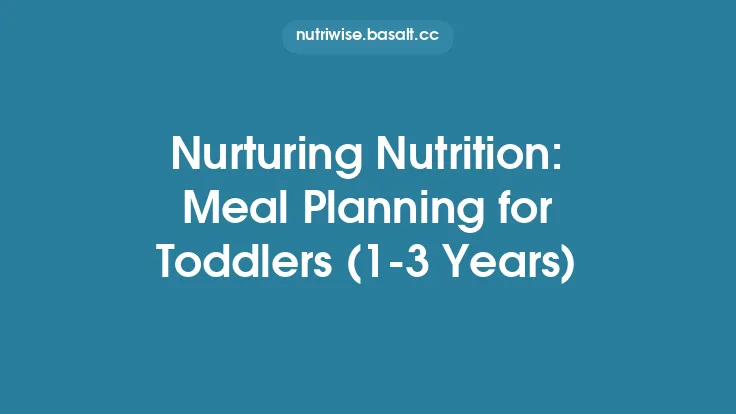Infants thrive on a diet that is primarily breast milk or formula during the first six months of life. This provides all the calories, protein, fat, vitamins, and minerals they need for rapid growth and brain development. However, as babies approach the six‑month mark, their digestive systems mature, and they develop the oral motor skills necessary to handle foods beyond liquid nutrition. Introducing solid foods at the right time, in the right way, lays the foundation for healthy eating habits, supports nutrient needs that breast milk or formula alone can no longer fully meet, and helps prevent feeding difficulties later in childhood.
Understanding Infant Nutritional Needs (0‑6 Months)
| Nutrient | Primary Source | Why It Matters for Infants |
|---|---|---|
| Protein | Breast milk, formula | Supports tissue growth, organ development, and immune function. |
| Fat | Breast milk, formula (especially DHA) | Critical for brain development, energy, and absorption of fat‑soluble vitamins (A, D, E, K). |
| Carbohydrates | Lactose in milk | Primary energy source; also aids in gut health. |
| Iron | Breast milk (low), formula (fortified) | Stores are built up in the third trimester; infants need additional iron after 4–6 months to prevent anemia. |
| Zinc | Breast milk, formula | Essential for immune function and cellular growth. |
| Vitamin D | Breast milk (low), formula (fortified) | Supports calcium absorption and bone health; supplementation is often recommended. |
| Calcium | Breast milk, formula | Needed for bone mineralization and muscle function. |
| Omega‑3 fatty acids (DHA/EPA) | Breast milk (varies with maternal diet), formula (fortified) | Crucial for retinal and neural development. |
During the first six months, the infant’s gut microbiome is still establishing itself, and the immune system is learning to differentiate between harmless foods and potential allergens. This makes the timing and method of solid food introduction especially important.
When to Start Solids: Signs of Readiness
Most health organizations, including the World Health Organization (WHO) and the American Academy of Pediatrics (AAP), recommend exclusive breastfeeding or formula feeding for the first six months. However, many infants show readiness cues a little earlier, typically between 4 and 6 months. Look for the following signs before offering solids:
- Head Control – Able to sit upright with minimal support and keep the head steady.
- Decreased Tongue‑Thrust Reflex – The reflex that pushes food out of the mouth diminishes, allowing the baby to move food to the back of the throat.
- Interest in Food – Watching others eat, reaching for food, or opening the mouth when food is presented.
- Increased Appetite – Appears unsatisfied after a regular milk feed, indicating a need for additional calories.
If any of these signs are present, it is safe to begin the gradual introduction of solid foods while continuing regular milk feeds.
Key Nutrients and Food Groups for Early Solids
| Food Group | Recommended First Foods | Nutrient Highlights |
|---|---|---|
| Iron‑rich cereals | Single‑grain rice or oatmeal cereal (iron‑fortified) | Provides iron and zinc; easy to mix with breast milk or formula for a familiar texture. |
| Pureed vegetables | Sweet potatoes, carrots, peas, squash | Rich in beta‑carotene (vitamin A), fiber, and potassium. |
| Pureed fruits | Apples, pears, bananas, avocados | Supplies vitamins C and K, natural sugars for energy, and healthy fats (avocado). |
| Protein sources | Pureed lentils, well‑cooked and pureed chicken or turkey, tofu | Adds essential amino acids, iron, and additional zinc. |
| Healthy fats | Avocado, small amounts of unsalted butter or olive oil mixed into purees | Supports brain development and provides extra calories. |
Note: Introduce one new food at a time, waiting 3–5 days before adding another. This approach helps identify any potential allergic reactions or intolerances.
Sample Meal Plans by Age (4–6 Months)
Below are flexible, nutrient‑dense meal plans that can be adapted to the infant’s preferences and developmental stage. All meals are pureed or very finely mashed to ensure safety and ease of swallowing.
4–5 Months (Early Introduction)
| Time | Meal | Portion (approx.) | Preparation |
|---|---|---|---|
| Morning | Breast milk or formula | 4–6 oz | As usual |
| Mid‑morning | Iron‑fortified rice cereal | 1–2 tbsp mixed with 2–3 oz breast milk or formula | Stir to a smooth, runny consistency |
| Afternoon | Breast milk or formula | 4–6 oz | As usual |
| Evening | Pureed sweet potato | 1–2 tbsp | Steam sweet potato until soft, blend with a little breast milk |
| Before Bed | Breast milk or formula | 4–6 oz | As usual |
5–6 Months (Expanding Variety)
| Time | Meal | Portion (approx.) | Preparation |
|---|---|---|---|
| Morning | Breast milk or formula | 4–6 oz | As usual |
| Mid‑morning | Oatmeal cereal + fruit puree | 2 tbsp cereal + 1 tbsp apple puree | Mix cereal with formula, swirl in fruit puree |
| Afternoon | Breast milk or formula | 4–6 oz | As usual |
| Early Evening | Pureed peas + chicken | 1 tbsp peas + 1 tsp finely pureed chicken | Steam peas, cook chicken thoroughly, blend together |
| Evening | Breast milk or formula | 4–6 oz | As usual |
6 Months (Transition to More Textured Foods)
| Time | Meal | Portion (approx.) | Preparation |
|---|---|---|---|
| Morning | Breast milk or formula | 4–6 oz | As usual |
| Mid‑morning | Mixed grain cereal (rice + oatmeal) | 2–3 tbsp mixed with formula | Slightly thicker than earlier stages |
| Mid‑day | Pureed avocado + banana | 1–2 tbsp each, mashed together | No added sugar; natural sweetness from banana |
| Afternoon | Breast milk or formula | 4–6 oz | As usual |
| Early Evening | Lentil puree + carrot | 1 tbsp each, blended | Cook lentils until very soft, steam carrots, blend |
| Evening | Breast milk or formula | 4–6 oz | As usual |
Tips for Adjusting Portions:
- Observe satiety cues: If the baby turns away, closes the mouth, or seems uninterested, stop feeding.
- Gradual increase: As the infant gets comfortable, slowly increase the thickness and volume of purees.
- Maintain milk intake: Solids should complement, not replace, breast milk or formula until the infant is eating a variety of foods and gaining weight appropriately.
Safety Guidelines for Introducing Solids
- Texture Matters – Start with a smooth, runny puree and gradually progress to thicker, lumpier textures as oral motor skills develop.
- Temperature Check – Serve foods at room temperature or slightly warm; never hot enough to burn the mouth.
- Avoid Choking Hazards – Never give whole grapes, raw carrots, nuts, popcorn, or large chunks of cheese. All foods should be pureed or mashed until the infant can handle more solid textures (usually after 9–12 months).
- Hygiene – Wash hands, sterilize feeding utensils, and ensure all surfaces are clean. Use fresh, refrigerated ingredients and discard any leftovers after 24 hours.
- Allergy Awareness – Introduce common allergens (e.g., peanut butter, egg yolk) one at a time after the infant has tolerated several other foods. Current guidelines suggest that early introduction of allergens may reduce the risk of developing food allergies, but always discuss with a pediatrician if there is a family history of severe allergies.
- No Added Salt or Sugar – Infants’ kidneys cannot handle excess sodium, and added sugars can predispose them to a preference for sweet foods later in life.
Common Challenges and Solutions
| Challenge | Practical Solution |
|---|---|
| Refusal of new foods | Offer the same food up to 10–15 times over several days; infants may need repeated exposure before acceptance. |
| Gagging | Gagging is a normal protective reflex. Keep the infant upright, offer smaller spoonfuls, and stay calm. |
| Constipation | Increase fluid intake (more breast milk/formula) and introduce pureed prunes or pears. |
| Excessive spit‑up | Feed in a more upright position, pause between spoonfuls, and ensure the baby is not over‑fed. |
| Allergic reaction | Look for rash, swelling, vomiting, or difficulty breathing. Stop the food immediately and seek medical attention. |
Monitoring Growth and Development
Regular pediatric check‑ups remain essential. During each visit, the healthcare provider will assess:
- Weight‑for‑age and length‑for‑age percentiles – Ensure the infant is following a healthy growth curve.
- Developmental milestones – Sitting, reaching, and hand‑to‑mouth coordination.
- Nutrient status – Blood tests for iron, vitamin D, and other key markers may be ordered if there are concerns.
If growth falters or the infant shows signs of nutrient deficiency (e.g., pallor, irritability, delayed milestones), the pediatrician may recommend fortified foods, supplements, or adjustments to the feeding plan.
Frequently Asked Questions
Q: Can I start solids before 4 months if my baby seems eager?
A: Most experts advise waiting until at least 4 months, as the digestive and motor systems are typically not mature enough before then. Early introduction before 4 months may increase the risk of choking and gastrointestinal issues.
Q: How much breast milk or formula should I continue after starting solids?
A: Until the infant is about 9–12 months old, breast milk or formula should still provide about 70–80% of total calories. Solids gradually increase to become the primary source of nutrition after the first year.
Q: Is it okay to mix water into purees?
A: Small amounts of water can be added to thin purees, especially if the infant is dehydrated or the puree is too thick. However, avoid giving large quantities of water, as it can interfere with nutrient absorption and lead to hyponatremia.
Q: When should I introduce iron‑rich foods?
A: Iron stores from birth typically last about 4–6 months. Introducing iron‑fortified cereals or pureed meats around 6 months helps prevent iron‑deficiency anemia.
Q: Are commercial baby foods necessary?
A: Not at all. Homemade purees can be just as nutritious when prepared with fresh, age‑appropriate ingredients. If using store‑bought options, choose those with no added sugars, salts, or preservatives.
Closing Thoughts
Introducing solid foods to infants between 0 and 6 months is a milestone that blends nutrition science with developmental readiness. By respecting the infant’s cues, offering a variety of nutrient‑dense foods, and adhering to safety guidelines, caregivers can set the stage for lifelong healthy eating habits. Remember that breast milk or formula remains the nutritional cornerstone during this period; solids are a complementary addition that supports emerging needs for iron, zinc, and texture experience. Consistent monitoring, patience, and a willingness to adapt the plan as the baby grows will ensure a smooth transition from liquid nourishment to a balanced, solid‑food diet.





